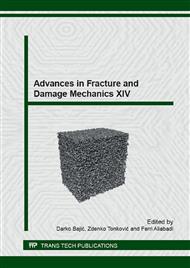p.117
p.121
p.125
p.129
p.133
p.137
p.141
p.145
p.149
Influence of Semi-Circular Cracks on Threaded Connection Fatigue by Means of Kitagawa-Takahashi Diagram and El Haddad Equation
Abstract:
Evaluation of semi-circular surface crack influence on threaded connection fatigue behavior, made of 42CrMo4 heat treatable steel, was carried out. Crack diameters were defined as 0.02, 0.05, 0.1, and 0.15 mm. Influence of semi-circular surface cracks was investigated by means of Kitagawa–Takahashi diagram and El Haddad equation. Assessments were done for survival probability of 99% on detailed FE model with normal metric thread profile and preload force at 70% of force at bolt yield point. The most critical location on threaded connections usually are thread roots which contain a very high notch effect. In order to accurately consider multiaxial stress field in thread root, multiaxial fatigue stress criterion based on a critical plane theory for fatigue assessment, was used. Mean stress influence was taken into account by means of Haigh diagram. Variable amplitude loading history of low-high (Lo-Hi) sequence spectrum was analyzed with the numerical algorithm of Rainflow cycle counting in the time domain. Fatigue damage was calculated according to the modified Palmgren-Miner linear damage accumulation hypothesis.
Info:
Periodical:
Pages:
133-136
Citation:
Online since:
September 2015
Authors:
Price:
Сopyright:
© 2016 Trans Tech Publications Ltd. All Rights Reserved
Share:
Citation:


